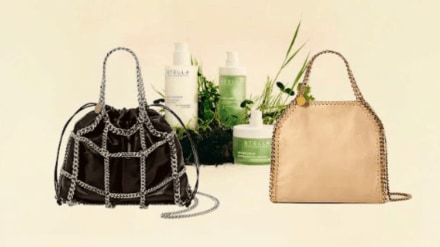When Reliance Brands announced its partnership with Stella McCartney to bring the British designer’s conscious luxury label to India, the question uppermost on everybody’s mind was whether Indian consumers were ready to embrace values over visibility, and ethics over emblems.
The partnership, which will introduce McCartney’s ready-to-wear collections alongside her vegan accessories and footwear through a multichannel distribution model, represents Reliance Brands’ calculated bet on an evolving consumer cohort that experts describe as the ‘conscious connoisseur’. “Stella McCartney isn’t just another brand; it’s a category creation play for Reliance, targeting a high-value, low-volume segment that has disproportionate influence on the luxury category as a whole,” says Subarna Mukherjee, founder and global CEO at Shop Culture.
Founded in 2001 as a conscious luxury brand, Stella McCartney has never used leather, feathers, fur or exotic skins in her collections, positioning the brand as a prominent voice in responsible design. Its India entry is well-timed. India’s luxury goods revenue is projected at $23 billion for 2025, with an anticipated annual growth rate of 5.9% into 2030. Penetration of sustainability-led luxury offerings has doubled in recent years to reach an estimated 8% as of October 2025. “Luxury is no longer about rarity; it’s about relevance,” says Ashita Aggarwal, professor of marketing at S.P. Jain Institute of Management and Research.
The decision to bring Stella McCartney to India was driven by its strong performance on Reliance’s online multi-brand luxury platform Ajio Luxe, where the brand consistently ranked among the top three handbag labels. That gave the brand confidence that Indian consumers were ready for a more comprehensive introduction to the designer’s philosophy. The brand will now be available through standalone brand stores and multi-brand luxury formats like White Crow and Ajio Luxe.
The potential is hard to ignore. Yasin Hamidani, director at Media Care Brand Solutions, projects that ethical luxury could grow to 12–15% in the next five years. “As awareness deepens and infrastructure improves, luxury with a conscience will shift from being a differentiator to an expectation,” he observes.
Mukherjee offers a more bullish forecast, suggesting ethical luxury could capture nearly 20% of the market by 2030. “What’s shaping the next wave of growth is conscious consumption. It would be driven by what I call the ‘crossover consumer’, the affluent Gen Z or millennial who now expects ethos from their luxury purchases,” she notes.
Behind India’s luxury surge lies a powerful catalyst: government policy. Liberalised FDI norms in single-brand retail have opened doors for global heavyweights like Louis Vuitton and Dior to expand their presence. Simultaneously, infrastructure upgrades have made high-end consumption more accessible.
Loud versus ethical
Lata Madhu, founder of Collage, says India is ready for ‘conscience luxury’ because we are culturally rooted in it. Says Madhu, “For the longest time, luxury brands were a clear sign of arrival. That is changing rapidly, especially among younger and well-travelled consumers. The new status symbol isn’t just about what you can afford; it’s also about what you choose not to support. Choosing a cruelty-free, values-driven brand is an act of sophisticated defiance against the old, industrialised luxury model.”
That being said, a brand like Stella McCartney must find its way into the wardrobe of the quiet luxury customers. “There are two kinds of consumers in luxury segments,” says Aggarwal. “One that thrives on loud luxury and visible names, and the other group that is made of people who like quiet luxury. The underlying motivation of these segments is different. The first one wants to be noticed, and the second one wants to feel special,” she explains.
That might not be an unknown territory for the company, which retails brands like Bottega Veneta and Salvatore Ferragamo, brands that represent ‘quiet luxury’, alongside more logo-forward labels like Versace.
However, hitting the bullseye is not just about perfect hand-eye coordination. The hitter’s stance, posture and balance must all be in sync when stepping up to the oche. For a brand in a relatively new arena, cultural and economic factors must be in tandem.
Anirudh Sanjeev, senior vice-president at NewsReach India, identifies several critical factors that will determine whether the McCartney model will work in India. “Cultural factors such as evolving attitudes toward ethical consumption and animal welfare; economic factors like apt pricing strategy to balance out premium positioning with perceived value, managing import duties and taxes will impact accessibility and uptake.” Additionally, infrastructure, online availability, and customer support will be equally critical, he says.
The challenge, as Sanjeev articulates, lies in balancing storytelling with product appeal. “Highlight sustainability credentials, ethical sourcing, and craftsmanship in a way that resonates culturally, connecting environmental impact to Indian sensibilities. Offer designs that are aspirational, using recognisable cues like signature patterns,” he says.
